1. Introduction
In all of my posts on grammar instruction I have made the very important point that for grammar to be fully acquired it must be practised extensively through all four skills. However, this is not what usually happens, grammar practice occurring in most language classrooms predominantly through the written medium. Hence grammar is mostly read and written, but rarely processed aurally and orally.
Of the four language skills, the one that is always neglected in grammar instruction is definitely Listening. In the typical grammar lesson, the target grammar structure is hardly ever practised through the aural medium.This may not only negatively impact acquisition of that structure, but also listening proficiency development at large. Why? The answer refers to the so-called parsing phase of listening comprehension.
The parsing phase is the stage in the comprehension of aural input in which the listener recognizes a grammar pattern in a string of words and fits it to the surrounding linguistic context. This important stage is paramount not simply to listening comprehension but also to acquisition, because pattern recognition facilitates the chunking of new L2 items and their assimilation in the learner’s existing L2-system.
In this post I intend to show how grammar can be modelled and practised aurally through highly impactful L.A.M. (Listening As Modelling) activities requiring relatively little preparation which I use regularly in my lessons.
2.L.A.M. grammar activities
2.1 Sentence puzzles
Sentence puzzles like the one in Figure 1 below are a very effective way to teach grammar and syntax through listening. The students are provided a set of jumbled-up sentences to unscramble whilst the teacher utters them in the correct order. The task is for the students to re-write them correctly in the table/grid provided, placing each element of the sentence under the right heading. After completing the transcribing task, the students are charged with inductively working out the rule. The example in Figure 1 focuses on the use of key negatives in English.
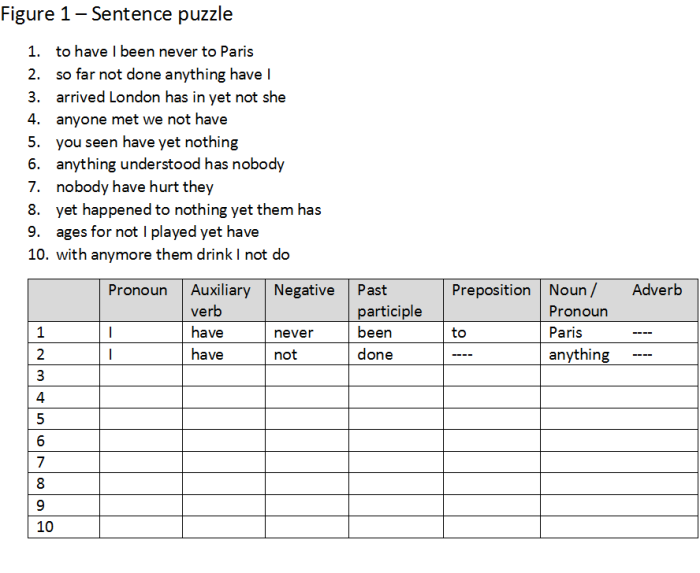
Whilst writing the words under each heading in the table the students build an awareness of how word order works, at the same time learning what word class each item belongs in, and all this through the aural medium, thereby combining three skills (listening, reading and writing) together. When the meaning of each word is provided in brackets, new vocabulary is also learnt.
2.2 Sentence builders
Sentence builders take a bit more time to make, but they can be exploited in so many ways that their surrender value is more than worth the effort. The teacher makes and utters sentences using the various chunks of language in the table to demonstrate how the target structure works. Whilst the teacher models the sentences, the students write down their meaning on mini whiteboards. As a follow-up, the students are tasked with working out the rule inductively. Since you are modelling, not testing comprehension, the sentences should be uttered at moderate speed. The example below focuses on the use of negatives and can be used as a follow-up or as a precursor to the sentence puzzle in Figure 1.
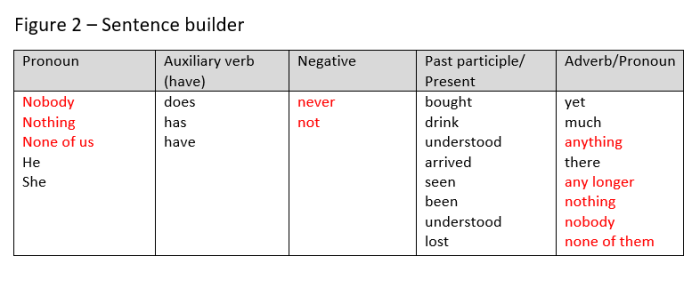
2.3 Sorting tasks
The teacher utters a number of sentences each containing a specific structure that s/he wants to draw the students’ attention to. As they listen, the students are tasked with categorizing the structure using a grid or table. In the first example provided in Figure 3, below, the task requires the students to categorize the different verb forms employed in ten sentences uttered by the teacher to reinforce phonological and grammar awareness. Students enjoy sorting tasks; I do them in every single lesson of mine, often exploiting songs.

2.4 Listening hunts
In listening hunts the teacher reads a short narrative and the students are asked to spot and write down as many instances as possible of the target structure(s) contained in the text. I usually tell the students in advance the number of occurrences of the target items in order to enhance their focus.

2.5 Interlingual comparisons
This technique is particularly effective when the word order in which the target structure is deployed in the L2 is markedly different from the L1. As the example in Figure 5 below shows, erroneous versions of target structure use are provided resulting from word-for-word translation from L1 to L2. The teacher will dictate the correct version of each sentence which will be written right under the flawed version. The students are then charged with figuring out the differences between L1 and L2 usage and inductively work out the rule.

2.6. Find your match
This activity serves two purposes. Firstly, to practise decoding skills and pronunciation; secondly, aural processing of the target structure. The students are provided with cards containing simple sentences featuring the target structure(s). Each card contains four pieces of information about a person; each piece information on the cards has a match in four of the other cards. The task is to go around the classroom interviewing people in order to find the four persons whose cards match one’s own. This tasks is useful in that it elicits a lot of production and receptive processing of the target structure.
Fig 7 – Find your match (French negatives)
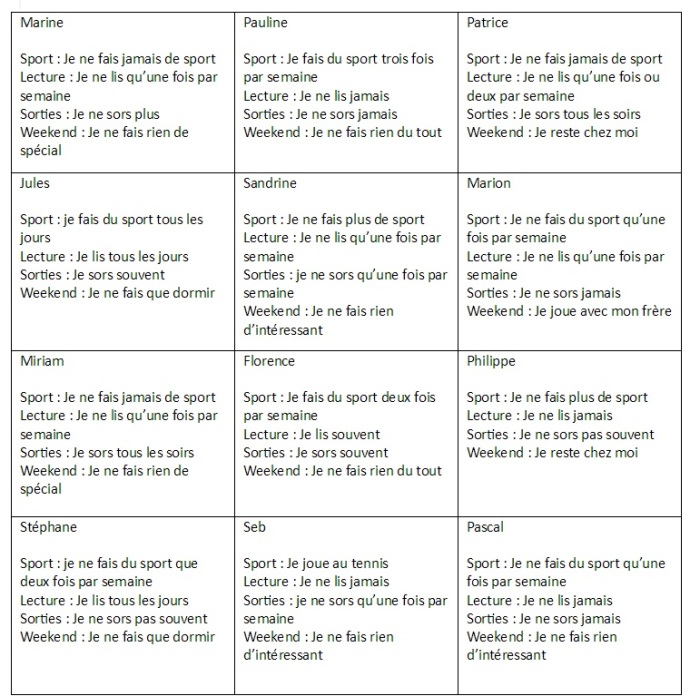
2.7 ‘Find someone who’ with cards
Each students is given a card with fictitious details and a grid with the details to look for. The task is to find the people with those details on their cards by asking questions in the target language. Although it may appear as a speaking task, this activity is actually mainly a listening one as the students read out aloud details in response to questions.
Fig.8 – Find someone who with cards (grid to fill in by students as they go around interviewing)
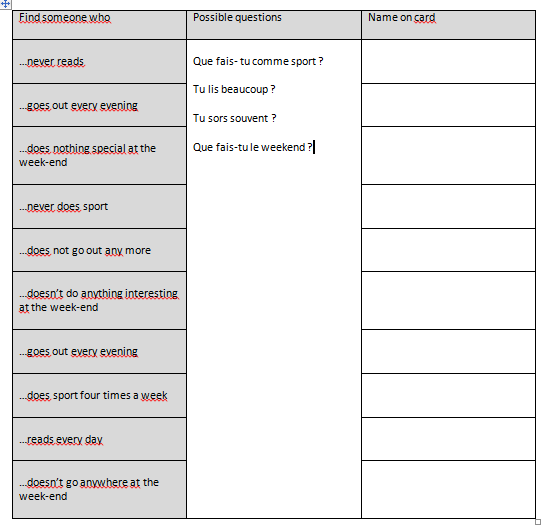
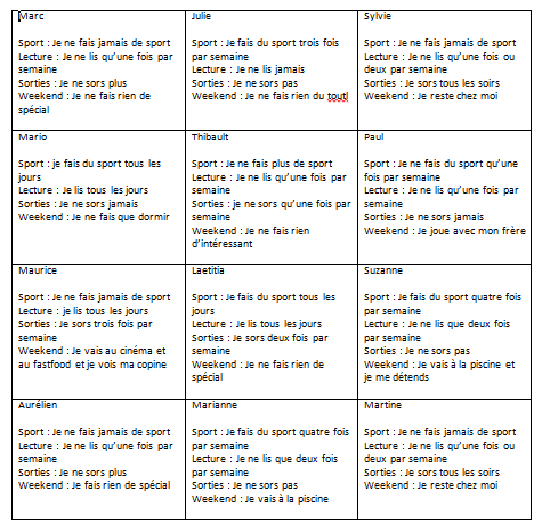
2.8 Partial dictations
Partial dictations are extremely easy to prepare and are very effective in focusing learners on the target structure. All one has to do is (1) create texts packed with instances of target structure use: (2) gap the texts where the target structure has been deployed; (3) read out the text whilst the students fill the gaps. Easy and highly effective. Tip: do not use one long text, use several short ones; it keeps the students more focused.
2.9 Songs with gapped lyrics to fill in
Songs with gapped lyrics to fill in as you play them are a great way to model and practise target language use in authentic contexts. Think about the song ‘Once I was seven years old’ by Lukas Graham; how useful for any teachers wanting to hammer in the past tense in English. The only issue, of course, is finding a song which contains a sufficient number of occurrences of the target structure. Once found one, all one has to do is to gap the song (do put the gapped words on display for less able students).
2.10 Interactive oral tasks
Any interactive oral task designed to elicit use of the target structure will obviously provide the students with plenty of aural processing as well as production practice. It is not the scope of this post, but I reserve to deal with ways to provide oral production practice in target structure use in a future post
2.11 Concluding remarks
Grammar must be heard, read, spoken and written by our learners if we want them to fully acquire it. This multi-sensorial approach to grammar instruction is rarely implemented in language lessons. The skill that is most neglected in grammar instruction is undoubtedly Listening, regardless of the fact that the brain is naturally wired to acquire grammar acoustically. More effort must be put by teachers in this area of grammar teaching by integrating traditional activities with skill-based approaches to instruction which provide extensive receptive oral practice through Listening-As-Modelling activities (LAM) and oral interaction.
For more on my ideas on listening, get hold of the book co-authored with Steve Smith ‘The language teacher toolkit’ available on www.amazon.co.uk

Great article.
I am surprised to read that explicitly teaching grammar rules is an affect method of teaching english, especially as a foreign language when there are so many scholars saying otherwise. on the other hand, practice is indeed different than theory!
I am currently a graduate student studying an MSEd in TESOL at UPENN. You mention integrating mustc in your teaching curriculum. Did you form this technique yourself? If not, could you send me the source? I would be very interested in reading more about this.
Diego Zelaya
LikeLiked by 2 people
Created it myself I am afraid 🙂
LikeLike
This is a great piece of article.
I have attended to English school for a year and they focus so much in grammar.
Filing-the-blanks/gaps like excercises were the most kind of activities I have found there.
I have good knowledge on grammar and vocabulary, well, I believe I have, but I do not have the skill that links gammar/vocabulary to listening/speaking.
I don’t know anyone who is prone or willing to practice English with me.
I trying to find a way to solve this issue.
Well anyway, bye!
LikeLike
Thank you Leonardo
LikeLike
Thank you Gianfranco Conti for example 2.5 https://gianfrancoconti.wordpress.com/2016/12/03/teaching-grammar-through-listening-english-as-a-foreign-language-version/#comments, it gave me an idea for an easy-level translation exercise for the detection of interferences.
LikeLiked by 1 person
Cool l. Thank you!!!
LikeLike
[…] this post, grammar instruction nearly always begins with modelling of target grammar use through a L.A.M. (Listening-As-Modelling ) activity such as a sentence-builders, sentence puzzles or cognitive […]
LikeLike
Hi Gianfranco,
Just to let you know that we’ve shortlisted this blog post for this month’s TeachingEnglish blog award and I’ll be putting up a post about it on today’s TeachingEnglish Facebook page http://www.facebook.com/TeachingEnglish.BritishCouncil, if you’d like to check there for comments.
Best,
Ann
LikeLiked by 1 person
Great news. Thank you, Ann 🙂
LikeLike
[…] new favourite speaking/listening task. For a detailed explanation look at 2.7 on Gianfranco Conti’s blog. The example Gianfranco shares links to free time. I have used it for future tense practice […]
LikeLiked by 1 person
[…] this respect (see examples below). I do sentence puzzles or the other similar activities described in this post every […]
LikeLiked by 1 person
[…] grammar through L.A.M. (Listening-As-Modelling) tasks I devised. In a more recent article, ‘They can’t learn what they can’t notice’ posted last week, I concerned myself with the issue of saliency, discussing how the extent to which an L2 item or […]
LikeLike
[…] in the input. Sentence builders, substitution tables, sentence puzzles and other tasks described (here) were used to focus students on […]
LikeLiked by 1 person
[…] in the input. Sentence builders, substitution tables, sentence puzzles and other tasks described (here) were used to focus students on […]
LikeLike
[…] implications for listening instruction are obvious: focus on pattern recognition of the sort envisaged here is highly beneficial for L2 […]
LikeLike
Reblogged this on Site Title.
LikeLike